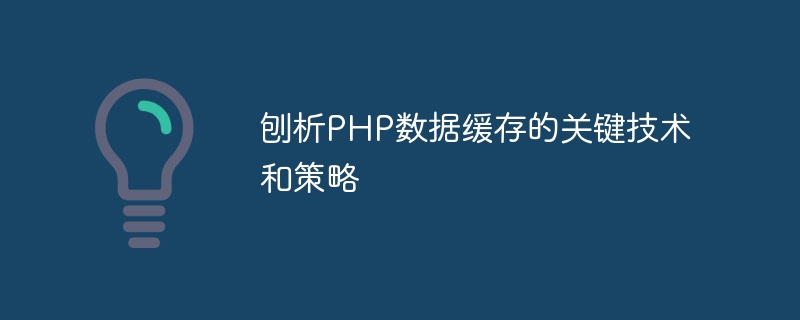

Analysis of the key technologies and strategies of PHP data caching
Introduction:
Nowadays, with the development of Internet applications, data caching has become an important part of Web development. Indispensable part. In PHP development, data caching can not only improve the performance and response speed of the system, but also reduce the load on the database, thus improving the stability of the entire system. This article will delve into the key technologies and strategies of PHP data caching, and deepen understanding through practical code examples.
1. Working principle of data caching
The basic principle of data caching is to store frequently accessed data in memory, and read it directly from memory in subsequent accesses, avoiding access to disk data. s expenses. In PHP, we can use various caching technologies to implement data caching, such as file caching, memory caching, database caching, etc.
2. File caching technology
File caching is the simplest and most common caching technology. The specific implementation method is as follows:
// 写入缓存
function writeCache($key, $data)
{
$file = CACHE_PATH . '/' . md5($key) . '.cache';
file_put_contents($file, $data);
}
// 读取缓存
function readCache($key)
{
$file = CACHE_PATH . '/' . md5($key) . '.cache';
if (file_exists($file)) {
return file_get_contents($file);
}
return false;
}
// 示例代码
$key = 'user_info';
$data = readCache($key);
if ($data === false) {
// 从数据库中获取数据
$data = fetchDataFromDatabase($key);
// 写入缓存
writeCache($key, $data);
} else {
// 从缓存中获取数据
$data = unserialize($data);
}The advantages of file caching are that it is simple and easy to understand and has low implementation cost. However, due to the high overhead of file I/O, it is suitable for caching small amounts of data, but is not suitable for large-scale data caching.
3. Memory cache technology
Memory cache is currently the most widely used cache technology, which mainly uses in-memory databases (such as Memcached and Redis) to store data. The specific implementation method is as follows:
// 写入缓存
function writeCache($key, $data, $expire = 3600)
{
$cache = new Redis();
$cache->connect('127.0.0.1', 6379);
$cache->setex($key, $expire, serialize($data));
}
// 读取缓存
function readCache($key)
{
$cache = new Redis();
$cache->connect('127.0.0.1', 6379);
$data = $cache->get($key);
if ($data === false) {
return false;
}
return unserialize($data);
}
// 示例代码
$key = 'user_info';
$data = readCache($key);
if ($data === false) {
// 从数据库中获取数据
$data = fetchDataFromDatabase($key);
// 写入缓存
writeCache($key, $data);
}The advantage of memory cache is that it has fast reading and writing speed and is suitable for caching large amounts of data. However, since the data is stored in memory, the cached data will be lost after the system is restarted and needs to be reloaded from the database.
4. Database caching technology
Database caching is to cache data into a database, generally using MySQL or other relational databases. The specific implementation is as follows:
// 写入缓存
function writeCache($key, $data, $expire = 3600)
{
$db = new PDO(DSN, USERNAME, PASSWORD);
$stmt = $db->prepare("INSERT INTO cache_data (`key`, `data`, `expire_time`) VALUES (?, ?, NOW() + INTERVAL ? SECOND) ON DUPLICATE KEY UPDATE `data` = VALUES(`data`), `expire_time` = VALUES(`expire_time`)");
$stmt->execute([$key, serialize($data), $expire]);
}
// 读取缓存
function readCache($key)
{
$db = new PDO(DSN, USERNAME, PASSWORD);
$stmt = $db->prepare("SELECT `data` FROM cache_data WHERE `key` = ? AND `expire_time` >= NOW()");
$stmt->execute([$key]);
$data = $stmt->fetchColumn();
if ($data === false) {
return false;
}
return unserialize($data);
}
// 示例代码
$key = 'user_info';
$data = readCache($key);
if ($data === false) {
// 从数据库中获取数据
$data = fetchDataFromDatabase($key);
// 写入缓存
writeCache($key, $data);
}The advantage of database caching is persistent storage and data will not be lost. However, since each read and write requires interaction with the database, the speed is relatively slow and is suitable for caching data that changes infrequently.
5. Caching strategy
A reasonable caching strategy can further improve the performance of the system. The following are several commonly used caching strategies:
6. Summary
This article provides an in-depth analysis of the key technologies and strategies of PHP data caching, including file caching, memory caching and database caching. And through actual code examples, it shows how to implement data caching in PHP. Proper use of data caching can significantly improve system performance and stability, and is an indispensable part of web development. I hope this article can be helpful to everyone.
The above is the detailed content of Analyze the key technologies and strategies of PHP data caching. For more information, please follow other related articles on the PHP Chinese website!




